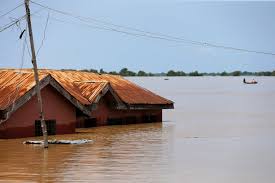The National Emergency Management Agency has disclosed that it has deployed its officials in 15 high-risk states to further enlighten residents on the impending floods and the need to relocate from flood-prone areas.
It added that the victims of the tragedy in Mokwa, Niger State lived mainly in gully areas and were caught unawares by the recent flooding disaster in the state, despite official warnings.
Head of the Press Unit at NEMA, Manzo Ezekiel, said the redflag states include: Kogi, Imo, Enugu, Adamawa, Taraba, Borno, Zamfara, Katsina and the Federal Capital Territory.
He lamented that several of the victims of May 23rd flooding built their residences in gully areas prone to flooding.
The flood in Mokwa, a commercial hub in Niger State, claimed over 200 lives, with hundreds of others declared missing.
The rainy season usually runs from April to October in Nigeria and last Wednesday, the Nigerian Meteorological Agency issued a forecast of heavy storms for Abuja and 14 of the country’s 36 states, including Niger.
Niger, Nigeria’s largest state by landmass, is home to three major dams – Kainji, Jebba and Shiroro – which contribute significantly to the country’s electricity grid. A fourth dam is under construction.
The state has been prone to flooding in recent times. In April, water released from one of the dams destroyed more than 5,000 farms in 30 communities, including in Mokwa. Reports suggested it was the sixth flood in the state this year.
In 2022, floods killed more than 600 people, displaced about 1.4 million and destroyed 440,000 hectares of farmland.
Ezekiel said, “Although Mokwa was identified as one of the local government areas that were at risk of being flooded, the magnitude at which it occurred was unprecedented. If you visit the location where the flooding happened, you will see that the houses were built in a big gully. And there are so many communities that are living in those kinds of areas.”
NEMA’s press chief maintained that although official warnings, which identified Niger State as being at risk of flooding, did not designate the state as ‘high risk,’ residents were obligated to remain alert.
“That is why we are saying that people should not relax, even those LGAs that were not identified. Because the forecasting agency did not mention that Mokwa LGA is at high risk, it is not an excuse for anybody or any community to relax. Everybody must be on alert. Every community needs to take a necessary step to forestall flooding in its area,” he admonished.
Ezekiel explained that victims who lived in gullies and other flood-prone areas were caught unawares.
“Of course, they didn’t see it coming,” he stated. “But you know, once a hydrological runoff cannot take the water that comes as a result of intensive rain, like what happened in that area, the likelihood that the community will be swept away is very high. And that is what has happened.”
The NEMA official acknowledged that Nigeria has “so many places that are at risk,” citing the 2024 Maiduguri flooding.
He warned, “It happened last year in Maiduguri. Nobody saw it coming that the Alau Dam would break and lead to that kind of thing. Every community needs to be on alert and take the necessary steps to forestall what happened in Mokwa from coming to their area.”
Meanwhile, the Federal Government said it has ramped up efforts to mitigate the impact of the flooding, working with state governments and emergency agencies.
Ezekiel revealed that the NEMA Director-General Zubaida Umar reported at the flood site within 24 hours.
“The NEMA DG arrived at that location less than 24 hours after the incident, to show the seriousness that NEMA attached to what had happened,” Ezekiel noted.
“Given the seriousness we attach to providing care and necessary support, we activated our operations office, and the Director of Search and Rescue was to strengthen support being provided at that location.’’
Ezekiel added that the NEMA DG’s activity on the flood site included raising awareness to prepare every community to handle floods.
The agency noted that it has escalated its anti-flooding advocacy nationwide, especially to reach citizens who seemed not to understand the anti-flooding message.









